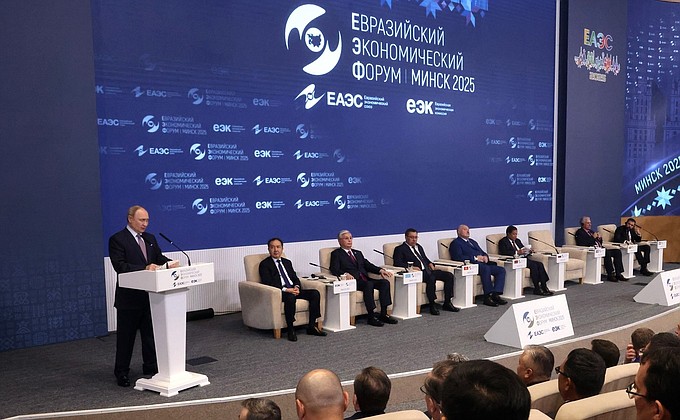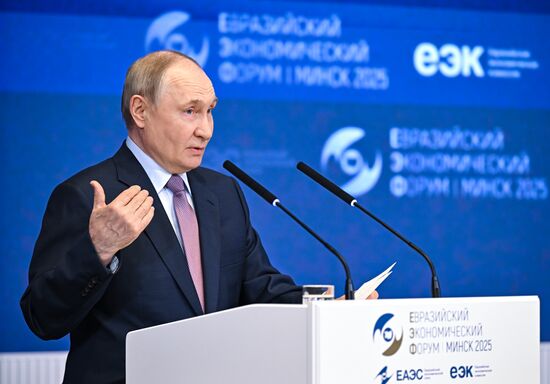Russia aims to strengthen financial settlement instruments in cooperation with integration partners
Russian President Vladimir Putin notes the importance and high level of the IV Eurasian Economic Forum held in Minsk. According to him, the Belarusian capital has brought together hundreds of representatives of large, medium and small Russian businesses. The Russian leader made his statement during the plenary session of the EEF-2025, which is being held in Minsk on June 26-27, 2025.
— These are those who are directly involved in the development of business ties with the EurAsEC countries and understand from their own experience what advantages integration provides and what else needs to be done to improve the conditions for mutual trade and investment exchanges, — the press service quotes the president as saying.
The Russian leader noted that on January 1, 2025, the Eurasian Economic Union celebrated ten years during which the union grew stronger and established itself as a successful integration association.
— The overall economic potential of the five countries has significantly strengthened, and the EurAsEC has rightfully established itself as one of the key centers of global development. The combined GDP of the Eurasian Union participants increased from $1.6 to $2.6 trillion. Trade turnover with third countries has increased by 38% and amounts to $800 billion. This is a completely comparable volume of trade between the world's leading economic powers. And the total volume of mutual trade within the union has doubled to $97 billion, with 93% of settlements between our states being conducted in national currencies, Vladimir Putin noted.
Industrial production in the EAEU countries has grown by 30%, manufacturing by 46%, of which agriculture by 26%. Investments in fixed assets have increased by more than 40%.
— What does it mean to “invest 40 percent in fixed assets”? This means that, at least in the medium term, growth is ensured, guaranteed, the money has already been invested. At the same time, the unemployment rate has decreased in the Eurasian Union to 2.8%. In Russia, it is 2.3%. This is one of the best indicators in the world today. Of course, the “five” are not going to stop there. Work continues on strengthening integration mechanisms, increasing the authority and influence of the Eurasian Economic Community in the international arena.
— Our association is always open to cooperation with all interested foreign partners. Mutually beneficial ties with the countries of Eurasia, Africa, Latin America are actively developing, contacts with multilateral structures are strengthening. You mentioned this now, said that these are BRICS, the CIS, the SCO, ASEAN, the African Union and others. The Eurasian Union has concluded a number of preferential agreements with major trading partners: Vietnam, Singapore, Serbia. In May, a free trade agreement with Iran came into force. God willing, the situation in the Middle East is calming down now, the conflict between Israel and Iran is also, thank God, all in the past. This means that it will be possible to develop relations with all countries in the region, including Iran, as I said, we have concluded a corresponding agreement with them.
— At the meeting of the Supreme Eurasian Council, it is planned to sign agreements on economic cooperation with the United Arab Emirates and Mongolia. Issues of trade liberalization with Indonesia, Egypt, and India are under discussion. Thus, our integration association makes a real contribution to the creation of a large space of partnership, cooperation and economic growth on our common Eurasian continent, a space where the right of each state to its own development model is respected and the interests of all participants are taken into account.
— On the interaction of the Eurasian Economic Community with global and regional financial institutions. I would like to note the following: the five countries are jointly making efforts to integrate the financial infrastructure. The Concept for the Formation of a Common Financial Market of the Union has been approved, the Eurasian Development Bank and the Eurasian Fund for Stabilization and Development have been created. These structures provide loans and expert support for projects with a high integration effect, and help ensure financial stability throughout the vast expanse of the Eurasian Economic Community. As of the beginning of this year, the Eurasian Stabilization Fund has accumulated about $9 billion. If necessary, they can be used to support the budgets of the five countries. The Eurasian Bank has accumulated an investment portfolio of $16.5 billion. It has financed the construction and modernization of power facilities in Kazakhstan and Kyrgyzstan, and the creation of agricultural production in Armenia. In Russia, the Eurasian Bank allocated funds for the construction of the Western High-Speed Diameter in St. Petersburg, the construction of a ring road, helped in the development of Pulkovo Airport, and the implementation of other infrastructure initiatives.
— Naturally, the Eurasian Union and its member states maintain extensive contacts with such key regional financial organizations as the New Development Bank of BRICS, the Asian Development Bank, the Asian Infrastructure Investment Bank and others.
As far as I remember, at one time even the World Bank helped the Eurasian Commission prepare recommendations for the implementation of the digital agenda of the Eurasian Economic Community. These recommendations were used in the work to ensure technological compatibility and harmonization of the legislation of the five countries in the digital sphere.
— However, if we talk directly about Russia, then due to well-known circumstances, our dialogue with the World Bank and other Western-centric financial institutions is difficult at this stage, to put it mildly. The reason is their political commitment. Moreover, we are doing everything we can to reduce our dependence on Western financial institutions, minimize the use of foreign payment instruments and services.
A transition to direct correspondent contacts with banks of the five countries has been made, many of them are connected to the financial messaging system of the Central Bank of Russia. The Eurasian Economic Community countries have also achieved significant success in integrating national payment systems and bank cards.
— We are currently working on creating a digital investment platform within BRICS. And of course, such ideas could be implemented in the Eurasian Economic Community as well. The same applies to other national payment instruments, national electronic payments, electronic money, and so on.
Without a doubt, regional financial institutions that are emerging on this basis will certainly multiply (territorial, regional), and will acquire a global character.
A significant amount of our Russian gold and foreign exchange reserves are frozen in Western banks. And they are constantly saying that they are going to steal our money. As soon as this happens, the movement towards regionalization of payment systems will certainly accelerate and will undoubtedly become irreversible. And this is generally beneficial for the global economy. Maybe it is worth paying for.
By the way, I just thought, after all, I have a basic legal education, I said "theft of our gold and foreign exchange reserves." Theft is a secret theft of property. And this is open. This is robbery.
And therefore, of course, we aim to further strengthen our own financial settlement instruments in this regard. We will do this in cooperation with the participants of the Eurasian Economic Community and with other friendly states - our like-minded people.
Own information
Business Eurasia

